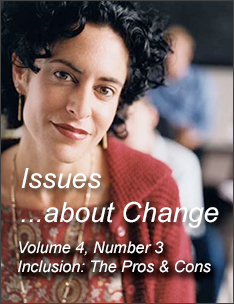So What's A School Leader To Do?
The support for a more inclusive approach to providing special educational services is significant. America's most basic values of freedom and equality of opportunity for everyone, the weight of significant educational research, and numerous legal mandates/court decisions are all on the side of greater inclusion. However, full inclusion, as outlined above, may be too extreme in that it actually does not allow for more restrictive educational alternatives for students whose educational needs may not be appropriately met in a regular classroom setting.
On the other hand, there is widespread concern about the attitudes and capacity of teachers and school organizations to provide appropriate educational services in regular classrooms across America to those who are not typical, mainstream, classroom students. These concerns are primarily focused on the following issues:
- classroom teacher expertise to construct and deliver appropriate educational services to those with disabilities efficiently and effectively;
- classroom teacher and school administrator attitudes toward working with students with disabilities;
- classroom teacher expertise to deal with inappropriate behaviors;
- the potential lowering of quality of educational services to all students; and
- inadequate material, curricular, technological, and human resources.
Before a school plunges headlong into such a major restructuring effort as greater inclusion, the above concerns must be adequately addressed. School leaders must put careful time and effort into the planning and implementation process. In earlier editions of Issues ... about Change (viz., Hord, 1991; Boyd, 1992), factors that increase the likelihood of implementing a significant change successfully have been identified and discussed. Specifically, school leaders must attend to six areas of concern:
- developing and articulating a clear, shared vision of the change;
- planning and providing for necessary resources;
- identifying and providing staff development and training to develop the skills needed to support and carry out the change;
- monitoring and evaluating (including monitoring of evolving personnel concerns about the change through the implementation process);
- providing ongoing consulting, coaching, and staff development to further enhance staff capacity to accomplish the goals of the targeted change; and
- working to create a school context that supports change.
In the case of implementing a more inclusive approach to providing special education and other specialized services in the regular classroom, several of these leader actions are important. School leaders must work diligently to develop and impart a clear vision of what an inclusive classroom looks like and how it functions. They must give significant attention to providing the kinds of ongoing staff development that expands the capacity of both regular and special education teachers to serve students with a variety of disabilities in a mainstream setting (e.g., cooperative learning strategies, team teaching skills, collaborating/team-building skills, individualizing instruction, mastery learning, identifying and adapting to different learning styles). Resources must be provided, including time for collaborative planning, support personnel that might be necessary, materials, and assistive technologies. Finally, school leaders must be mindful of the changing concerns that their staff, parents, and others have as greater inclusion begins to be implemented. By attending to these issues, a more inclusive educational system is possible.
Next Page: Resources for Further Information

